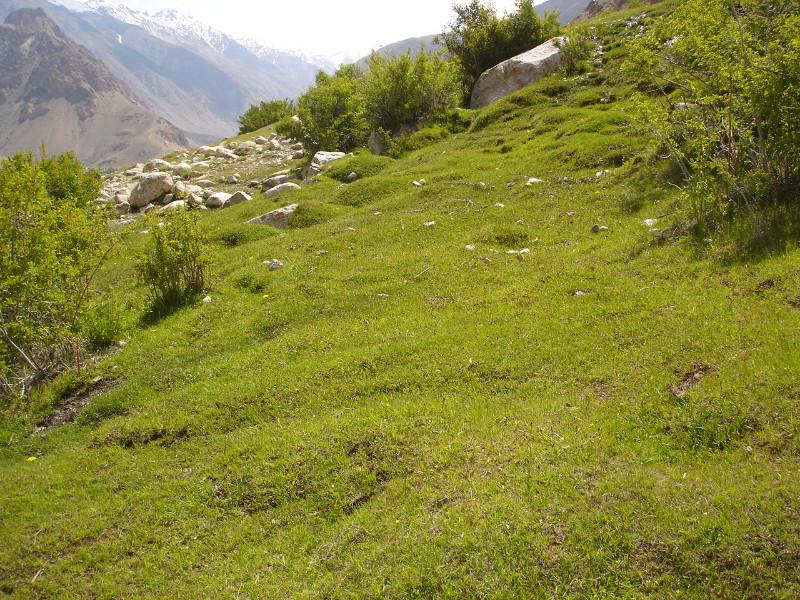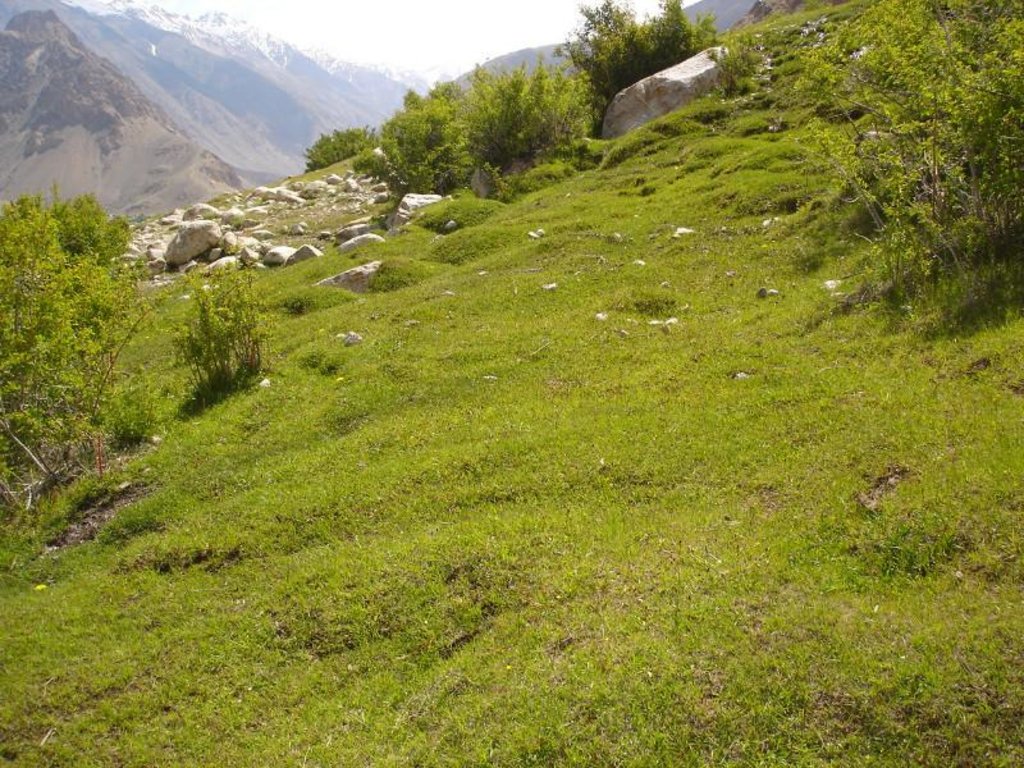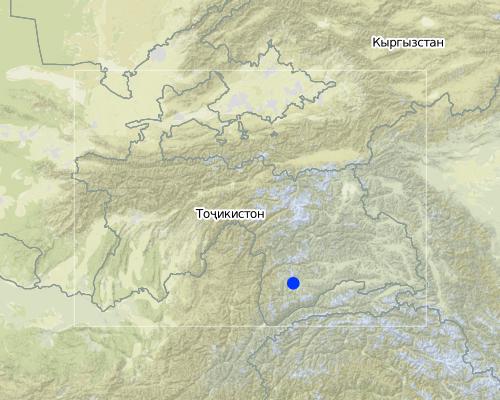Орошение и залужение высокогорных полупустынных пастбищ [طاجيكستان]
- تاريخ الإنشاء:
- تحديث:
- جامع المعلومات: Gulniso Nekushoeva
- المحرر: –
- المُراجع: David Streiff
technologies_1539 - طاجيكستان
عرض الأقسام
توسيع الكل طي الكل1. معلومات عامة
1.2 تفاصيل الاتصال بالأشخاص الرئيسيين لمصدر المعلومات والمؤسسات المشاركة في تقييم وتوثيق التقنية
متخصص في الإدارة المستدامة للأراضي:
متخصص في الإدارة المستدامة للأراضي:
اسم المؤسسة (المؤسسات) التي سهلت توثيق/تقييم التقنية (إذا كان ذلك على صلة)
Tajik Soil Insitute (Tajik Soil Institute) - طاجيكستاناسم المؤسسة (المؤسسات) التي سهلت توثيق/تقييم التقنية (إذا كان ذلك على صلة)
CDE Centre for Development and Environment (CDE Centre for Development and Environment) - سويسرا1.3 الشروط المتعلقة باستخدام البيانات الموثقة من خلال WOCAT
متى تم تجميع البيانات (ميدانيا)؟:
02/07/2010
يوافق جامع المعلومات والشخص (لاشخاص) الرئيسي لمصدر المعلومات على الشروط المتعلقة باستخدام البيانات الموثقة من خلال WOCAT:
نعم
2. وصف تقنيةالإدارة المستدامي للأراضي
2.1 وصف مختصر للتقنية
تعريف التقنية:
Орошение высокогорных полупустынных пастбищ способствует их быстрому естественному залужению, а камнеуборка –к улучшению поверхности и увеличению полезной площади пастбищ.
2.2 وصف تفصيلي للتقنية
الوصف:
Пастбища в Ванкале обычно сосредоточены на непригодных для земледелия каменистых горных склонах и конусах выноса боковых притоков р.Гунт. Скудная полукустарниковая растительность и перевыпас, обуславливают низкую продуктивность этих пастбищ. Жители кишлака Варшез, решили проблему с улучшением состояния пастбищ и обеспечения кормами, тем, что стали орошать все земли в границах своего села, между приусадебными участками, вокруг полей с зерновыми, картофелем, кормовыми и до большого оросительного канала (расположенного выше кишлака). Оросительный канал уже к этому времени существовал, так что дополнительных усилий не потребовалось. И довольно скоро, в добавок к обычным пастбищам выше оросителя они стали обладателями высокпродуктивного весеннее-осеннего пастбища внутри кишлака. Орошение пастбищ и камнеуборка, резко увеличивает их продуктивность, а расширение видового состава растительности улучшает её кормовую ценность. Таким образом, постепенно низкопродуктивные, сильнокаменистые пастбища преобразованы в высокопродуктивные залуженные пастбища с густым естественным разнотравьем.
Purpose of the Technology: Увеличение продуктивности сильнокаменистых высокогорных присельских пастбищ. Гарантированное самообеспечение домашнего скота кормами в весеннее- осенний период.
Establishment / maintenance activities and inputs: Для создания этой технологии финансовых затрат и тяжелого физического труда (по проведению ирригационного канала ) не потребовалось. В начале внедрения технологии– имеющаяся площадь пастбищ была распределена по количеству домохозяйств, проведена камнеуборка, проложена необходимая мелкая оросительную сеть вниз от ирригационного канала, с помощью которых воду подают к определенному участку, где уже орошение идет напуском.
Natural / human environment: Кишлак Варшез находится в Шугнанском районе ГБАО, в джамоате Ванкала, на левом берегу р.Гунт. Абсолютная высота 3200-3300м н.у.м. Лето короткое, в последнее время частые ночные заморозки. Годовое количество осадков -120-150мм . Местные жители сильно зависят от собственного производства. Основное их занятие – животноводство – яководство, осенью меняют живой скот (или их мясо) на продукты, уголь, керосин, вещи. Длительный период стойлового содержания скота 6-7 месяцев в году. Для которого необходимо заготовить достаточное количество кормов. Длинные расстояния до рынков, поэтому корма для зимнего содержания скота, здесь тоже острая необходимость. Пастбища между селами и выше канала сильно деградированы : сильно каменисты, с валунами на поверхности, с единичной ксерофитной полукустарниковой растительностью. С крайне малым запасом поедаемой травы. После залужения они превращаются в низкотравные пышные луга, весенне-осенние пастбища. Летом скот отгоняют на дальние пастбища (в сторону Восточного Памира) за это время трава успевает отрасти и опять готова к осеннему выпасу, местами- в мезопонижениях, где трава повыше, даже косят. Результат-улучшение проективного покрытия аридных высокогорных пастбищ за счет их орошения и залужения, увеличения их продуктивности (кормовой базы).
2.3 صور التقنية
2.5 البلد/المنطقة/المواقع التي تم تنفيذ التقنية فيها والتي يغطيها هذا التقييم
البلد:
طاجيكستان
المنطقة/الولاية/المحافظة:
Таджикистан
مزيد من التفاصيل حول الموقع:
ГБАО, Шугнанский район
Map
×2.6 تاريخ التنفيذ
في حالة عدم معرفة السنة بالتحديد، يرجى الإشارة إلى التاريخ التقريبي:
- منذ 10-50 سنة
2.7 إدخال التقنية
حدد كيف تم إدخال التقنية:
- من خلال ابتكار مستخدمي الأراضي
التعليقات (نوع المشروع، الخ):
после 90-х где-то 16-18 лет
3. تصنيف تقنية الإدارة المستدامي للأراضي
3.1 الغرض الرئيسي ( الأغراض الرئيسية) للتقنية
- الحد من تدهور الأراضي ومنعه وعكسه
3.2 نوع (أنواع) استخدام الأراضي الحالية حيث يتم تطبيق التقنية

الأراضي الزراعية
- زراعة سنوية
- زراعة معمرة (غير خشبية)

أراضي الرعي
أراضي الرعي الواسع النطاق:
- الرعي المرتحل
- رعي شبه مرتحل
التعليقات:
Major land use problems (compiler’s opinion): Низкое естественное плодородие каменистых маломощных почв, низкая продуктивность полупустынных пастбищ, перевыпас (выпас без учета продуктивности пастбищ ), деградация пастбищ.
Major land use problems (land users’ perception): Низкая продуктивность деградированных пастбищ, проблемы с обеспечением кормами скот в период длинного стойлового содержания – 6-7 месяцев в году.
Nomadism: Летом скот выпасают на дальних пастбищах. Яков (у кого есть) гонят в Мургаб.
Semi-nomadism / pastoralism: Зимой скот находится в стойлах с октября по май, только яки могут пастись на улице зимой.
Selective felling of (semi-) natural forests: Взрослые деревья ивы – через каждые 3г – обрубается верхние ветки- осенью- весной. По очереди. Облепиха – нижние ветки – по мере необходимости для семьи.
Problems / comments regarding forest use: Хотя ива и облепиха не прихотливые и быстрорастущие виды деревьев, но они очень влаголюбивы, это главное условие их существования , поэтому увеличение их площадей зависит от наличия поливной воды.
Forest products and services: древесина, топливо, выпас / веточное кормление
Future (final) land use (after implementation of SLM Technology): Grazing land: Gi: Intensive grazing/ fodder production
Constraints of wastelands / deserts / glaciers / swamps: Неправильное управление
إذا تغير استخدام الأراضي بسبب التقنية، قم بالإشارة إلى استخدام الأرض قبل تنفيذ التقنية:
Grazing land: Ge: Extensive grazing land
3.3 مزيد من المعلومات حول استخدام الأراضي
إمدادات المياه للأرض التي يتم تنفيذ التقنية عليها:
- ري كامل
التعليقات:
Water supply: полностью орошаемое, полностью орошаемое
عدد مواسم الزراعة في السنة:
- 1
حدد:
Longest growing period in days: 90
3.4 مجموعةالإدارة المستدامة للأراضي التي تنتمي إليها هذه التقنية
- الرعي وإدارة المراعي
- تحسين الغطاء الأرضي/النباتي
3.5 انتشار التقنية
حدد انتشار التقنية:
- منتشرة بالتساوي على مساحة
إذا كانت التقنية منتشرة بالتساوي على منطقة ما، فحدد المنطقة التقريبية المغطاة:
- < 0.1 كم2 (10 هكتار)
التعليقات:
Total area covered by the SLM Technology is 0.08 m2.
Технология распространена на пастбищных землях одного села, хотя есть потенциал дальнейшего распространения.
3.6 التدابير التقنية في مجال إلادارة المستدامة للأراضي

التدابير النباتية
- V1: غطاء من الأشجار والشجيرات
- V2: الأعشاب والنباتات العشبية المعمرة
- V5: أخرى

التدابير الإدارية
- M1: التغيير في نوع استخدام الأراضي
- M5: التحكم في/تغيير تركيبة الأنواع
التعليقات:
Main measures: vegetative measures, management measures
3.7 الأنواع الرئيسية من تدهور الأراضي التي تناولتها التقنية

تآكل التربة بالمياه
- (Wg):الانجراف الخلجاني/ الخلجان

التدهور الكيميائي للتربة
- (Cn): تراجع الخصوبة وانخفاض محتوى المادة العضوية (غير ناتج عن الانجراف)

التدهور البيولوجي
- (Bc): تناقص الغطاء النباتي
- (Bq): انخفاض الكمية/الكتلة الحيوية
- (Bl): فقدان الحياة بالتربة

تدهور المياه
- (Ha): التجفيف
التعليقات:
Main type of degradation addressed: Во (Wg): овражная эрозия / образование оврага, Бр (Bc): уменьшение растительного покрова, Да (Ha): аридность
Secondary types of degradation addressed: Ха (Cn): снижение плодородия почвы и органических веществ в почве (не вызванные эрозией), Бк (Bq): уменьшение количества / биомассы, Бж (Bl): потеря жизни в почвe
Main causes of degradation: управление землеи (Необходимость самообеспечения с 92-93г заставило население, увеличить поголовье скота, чтобы обменивать его на другие продукты.), чрезмерный выпас (Из-за невозможности после 90х вывести скот на дальние пастбища летом .и большого его количества на единицу площади пастбищ.), засуха (Высокая аридность, небольшое количество осадков, изреженный растительный покров.), интенсивная эксплуатация населением (Не нормированный выпас), бедность / богатство (Много бедных), война и конфликты (После кризиса 90х вынужены перейти на самообеспечение)
Secondary causes of degradation: обезлесивание / удаление естественной растительности (включая лесные пожары) (Отсутствие электричества, а затем его наличие по 2-3ч в день вынуждало и длинные суровые зимы, вынуждало вырубать все вокруг.), чрезмерное использование растительного покрова для бытовых целей, наличие работы (Работа есть только в школе, в больнице джамоата- но там все занято. Частный извоз-такси.), вводимый ресурс и инфраструктура: (дороги, рынки, распределение водных пунктов другие . (Есть хорошая дорога, удаленность от рынка), образование, доступ к знаниям и поддерживающие услуги (Есть школа, 2 мельницы, магазин)
3.8 منع أو حد أو عكس تدهور الأراضي
تحديد هدف التقنية فيما يتعلق بتدهور الأراضي:
- الحد من تدهور الأراضي
- اصلاح/إعادة تأهيل الأراضي المتدهورة بشدة
التعليقات:
Main goals: mitigation / reduction of land degradation, rehabilitation / reclamation of denuded land
Secondary goals: prevention of land degradation
4. المواصفات الفنية، وأنشطة التنفيذ، والمدخلات، والتكاليف
4.2 المواصفات الفنية/شروحات الرسم الفني
Technical knowledge required for land users: средний
Main technical functions: улучшение земляного покрова, улучшение поверхностной структуры (покрытие коркой, уплотнение), повышение органического вещества, повышение биомассы (количество)
Secondary technical functions: улучшение структуры верхнего слоя почвы (прессование), улучшение подпочвенной структуры (твердый надпочвенный слой), стабилизация почвы (например, с помощью корней деревьев против оползней), повышение наличия питательных веществ (снабжение, переработка отходов,...), повышение / поддержание сохранения воды в почве, содействие росту видов и сортов растительности (качество, например поедаемые кормовые культуры)
Trees/ shrubs species: Д- кустарники высокие шиповника – 1.5-2м, ива кустраниковая вдоль оросителей естественные
Grass species: Естественное разнотравье, хорошо разросшееся при орошении
Slope (which determines the spacing indicated above): 0%
Gradient along the rows / strips: 0%
Change of land use practices / intensity level: Низкопродуктивные пастбища превращены в высокопродуктивные орошаемые пастбища
Layout change according to natural and human environment: Ниже основного оросителя все земли между домохозяйствами орошаются и залужены, выше оросителя естественные каменистые пастбища
Control / change of species composition: На фоне орошения произошло естественное залужение пастбищ, увеличение доли поедаемых трав, скашивание сорняков и ядовитых видов
4.3 معلومات عامة بخصوص حساب المدخلات والتكاليف
عملة أخرى/ عملة وطنية (حدد):
сомони
أشر إلى سعر الصرف من الدولار الأمريكي إلى العملة المحلية (إذا كان ذا صلة): 1 دولار أمريكي =:
4,52
اذكر متوسط تكلفة أجر العمالة المستأجرة في اليوم الواحد:
7.00
4.4 أنشطة التأسيس
| النشاط | نوع التدبير | التوقيت | |
|---|---|---|---|
| 1. | Скашивание ядовитых и сорных растений | نباتية | 2 чел/дня |
| 2. | Полив напуском | نباتية |
4.6 الصيانة/الأنشطة المتكررة
| النشاط | نوع التدبير | التوقيت/الوتيرة | |
|---|---|---|---|
| 1. | Очистка поля от камней (камнеуборка) | زراعية | Ежегодно/весной |
| 2. | Полив | زراعية | |
| 3. | Рубка сухих веток шиповника | نباتية | Ежегодно/Весной, осенью |
| 4. | Полив пастбищ | نباتية | 4р в месяц |
| 5. | Выборочное скашивание естественной травы | نباتية | Ежегодно/2р-летом |
| 6. | Сбор плодов шиповника | نباتية | Ежегодноосенью |
4.7 التكاليف والمدخلات اللازمة للصيانة/للأنشطة المتكررة (سنويًا)
التعليقات:
Machinery/ tools: ручной труд + лопаты при поливе, ручной труд и вспашка быками/ лопата, серп, ручной труд, серп, коса, лопата
5. البيئة الطبيعية والبشرية
5.1 المناخ
هطول الأمطار السنوي
- < 250 مم
- 251- 500 ملم
- 501 - 750ملم
- 1,000-751 ملم
- 1,500-1,100 ملم
- 2,000-1,500 ملم
- 3,000-2,001 ملم
- 4,000-3,100 ملم
- > 4000 ملم
المنطقة المناخية الزراعية
- قاحلة
Thermal climate class: boreal. Только летом температура выше 10°С.
5.2 طوبوغرافيا
متوسط الانحدارات:
- مسطح (0-2%)
- بسيط (3-5%)
- معتدل (6-10%)
- متدحرج (11-15%)
- تلال (16-30%)
- شديدة الانحدار(31-60%)
- فائقة الانحدار (>60%)
التضاريس:
- هضاب/سهول
- أثلام مرتفعة
- المنحدرات الجبلية
- منحدرات التلال
- منحدرات في السفوح
- قاع الوادي
المنطقة الارتفاعية:
- 100-0 متر فوق سطح البحر
- 500-101 متر فوق سطح البحر
- 1,000-501 متر فوق سطح البحر
- 1,500-1,001 متر فوق سطح البحر
- 2,000-1,501 متر فوق سطح البحر
- 2,500-2,100 متر فوق سطح البحر
- 3,000-2,501 متر فوق سطح البحر
- 4,000-3,001 متر فوق سطح البحر
- > 4000 متر فوق سطح البحر
التعليقات والمواصفات الإضافية بشأن التضاريس:
Slopes on average: moderate (6-10%), rolling (11-15%), hilly (16-30%)
5.3 التربة
متوسط عمق التربة:
- ضحل جدًا (0-20 سم)
- ضحلة (21-50 سم)
- متوسطة العمق (51-80 سم)
- عميقة (81-120 سم)
- عميقة جدًا (> 120 سم)
قوام التربة (التربة السطحية):
- خشن / خفيف (رملي)
- متوسط ( طميي، سلتي)
المواد العضوية في التربة السطحية:
- عالية (>3%)
- متوسطة (1-3%)
5.4 توافر المياه ونوعيتها
منسوب المياه الجوفية:
50-5 م
توافر المياه السطحية:
جيد
نوعية المياه (غير المعالجة):
مياه شرب جيدة
5.5 التنوع البيولوجي
تنوع الأنواع:
- مرتفع
5.6 خصائص مستخدمي الأراضي الذين يطبقون التقنية
التوجه السوقي لنظام الإنتاج:
- الكفاف (الإمداد الذاتي)
- مختلط (كفاف/ تجاري)
الدخل من خارج المزرعة:
- 10-50% من جميع الإيرادات
المستوى النسبي للثروة:
- ضعيف
- متوسط
أفراداً أو مجموعات:
- فرد/أسرة معيشية
مستوى المكننة:
- الجر الحيواني
الجنس:
- نساء
- رجال
اذكر الخصائص الأخرى ذات الصلة لمستخدمي الأراضي:
Land users applying the Technology are mainly common / average land users
Population density: < 10 persons/km2
Annual population growth: < 0.5%
2% of the land users are rich.
58% of the land users are average wealthy.
40% of the land users are poor.
Market orientation of production system: subsistence (self-supply), subsistence (self-supply), subsistence (self-supply), mixed (subsistence/ commercial, mixed (subsistence/ commercial
5.7 متوسط مساحة الأرض المملوكة أو المستأجرة من قبل مستخدمي الأراضي الذين يطبقون التقنية
- < 0.5 هكتارا
- 0.5 - 1 هكتار
- 1 -2 هكتار
- 2 - 5 هكتار
- 5 - 15 هكتار
- 15 - 50 هكتار
- 50 - 100هكتار
- 500-100 هكتار
- 1,000-500 هكتار
- 10,000-1,000 هكتار
- > 10,000 هكتار
هل يعتبر هذا نطاقًا صغيرًا أو متوسطًا أو واسعا (في إشارة إلى السياق المحلي)؟:
- على نطاق متوسط
التعليقات:
Average area of land owned or leased by land users applying the Technology: < 0.5 ha, 0.5-1 ha, 1-2 ha, 1-2 ha, 2-5 ha, 5-15 ha
5.8 ملكية الأراضي، وحقوق استخدام الأراضي، وحقوق استخدام المياه
ملكية الارض:
- دولة
حقوق استخدام الأراضي:
- مؤجر
حقوق استخدام المياه:
- مجتمعي (منظم)
5.9 الوصول إلى الخدمات والبنية التحتية
الصحة:
- ضعيف
- معتدل
- جيد
التعليم:
- ضعيف
- معتدل
- جيد
المساعدة التقنية:
- ضعيف
- معتدل
- جيد
العمل (على سبيل المثال خارج المزرعة):
- ضعيف
- معتدل
- جيد
الأسواق:
- ضعيف
- معتدل
- جيد
الطاقة:
- ضعيف
- معتدل
- جيد
الطرق والنقل:
- ضعيف
- معتدل
- جيد
مياه الشرب وخدمات الصرف الصحي:
- ضعيف
- معتدل
- جيد
الخدمات المالية:
- ضعيف
- معتدل
- جيد
6. الآثار والتصريحات الختامية
6.1 الآثار التي أظهرتها التقنية في الموقع
الآثار الاجتماعية والاقتصادية
الإنتاج
إنتاج المحاصيل
إنتاج الأعلاف
جودة العلف
إنتاج حيواني
إنتاج الخشب
خطر فشل الإنتاج
تنوع المنتج
إدارة الأراضي
الدخل والتكاليف
دخل المزرعة
الآثار الاجتماعية والثقافية
الأمن الغذائي / الاكتفاء الذاتي
الآثار الايكولوجية
التربة
رطوبة التربة
غطاء التربة
دورة المغذيات/إعادة الشحن
المادة العضوية في التربة/تحت الطبقة c
التنوع البيولوجي: الغطاء النباتي، الحيوانات
الكتلة الحيوية/ طبقة الكربون فوق التربة
التنوع النباتي
التنوع الحيواني
الأنواع المفيدة
تنوع الموائل
مكافحة الآفات/الأمراض
الحد من مخاطر المناخ والكوارث
آثار الجفاف
انبعاث الكربون والغازات المسببة للاحتباس الحراري
6.3 تعرض التقنية وحساسيتها لتغير المناخ التدريجي والظواهر المتطرفة/الكوارث المرتبطة بالمناخ (كما يراها مستخدمو الأراضي)
تغير مناخ تدريجي
تغير مناخ تدريجي
| الموسم | نوع التغير المناخي/ المتطرف | كيف تتعامل التقنية مع ذلك؟ | |
|---|---|---|---|
| درجة الحرارة السنوية | زيادة | جيدا |
الظواهر المتطرفة / الكوارث المرتبطة بالمناخ
الكوارث الجوية
| كيف تتعامل التقنية مع ذلك؟ | |
|---|---|
| عاصفة ممطرة محلية | جيدا |
| عاصفة هوائية محلية | جيدا |
الكوارث المناخية
| كيف تتعامل التقنية مع ذلك؟ | |
|---|---|
| جفاف | ليس جيدا |
الكوارث الهيدرولوجية
| كيف تتعامل التقنية مع ذلك؟ | |
|---|---|
| فيضان عام (نهر) | جيدا |
العواقب الأخرى المتعلقة بالمناخ
العواقب الأخرى المتعلقة بالمناخ
| كيف تتعامل التقنية مع ذلك؟ | |
|---|---|
| انخفاض فترة النمو | ليس جيدا |
| понижению температуры (заморозки) |
التعليقات:
Проведена камнеуборка , скошены сорняки и ядовитые растения.
6.4 تحليل التكلفة والعائد
كيف يمكن مقارنة العوائد نسبة لتكاليف الإنشاء (من وجهة نظر مستخدمي الأراضي)؟
عوائد قصيرة الأجل:
إيجابي
عوائد طويلة الأجل:
ايجابي جدا
كيف تتم مقارنة العوائدمع كلفة الصيانة/التكاليف المتكررة (من وجهة نظر مستخدمي الأراضي)؟
عوائد قصيرة الأجل:
ايجابي جدا
عوائد طويلة الأجل:
ايجابي جدا
6.5 اعتماد التقنية
من بين جميع الذين تبنوا التقنية، كم عدد الذين فعلوا ذلك بشكل تلقائي، أي دون تلقي أي حوافز مادية/مدفوعات؟:
- 100-90%
التعليقات:
100% of land user families have adopted the Technology without any external material support
There is a moderate trend towards spontaneous adoption of the Technology
Comments on adoption trend: да имеется
6.7 نقاط القوة / المزايا / الفرص التي توفرها التقنية
| نقاط القوة/ المزايا/ الفرص من وجهة نظر مستخدمي الأراضي |
|---|
| Есть возможность заготовки высококачественного сена, рядом с домом. |
| Есть возможность выпаса скота недалеко от дома весной и осенью. |
| نقاط القوة/ المزايا/ الفرص من وجهة نظر جامع المعلومات أو غيره من الاشخاص الرئيسيين لمصدر المعلومات |
|---|
|
Орошаемые и залуженные пастбища обеспечивают скот высококачественными свежими кормами. How can they be sustained / enhanced? Надо провести подсев семян люцерны или эспарцета. |
|
Площадь орошаемых пастбищ может быть увеличена, т.к. многокилометровые оросительные каналы на всем своем протяжении проходят через пустынные низкопродуктивные пастбища. How can they be sustained / enhanced? Провести оросительную сеть ниже основного оросителя, провести камнеуборку, закрепить за домохозяйствами. |
6.8 نقاط ضعف / مساوىء / مخاطر التقنية وسبل التغلب عليها
| نقاط الضعف/ المساوىء/ المخاطر من وجهة نظر مستخدم الأراضي | كيف يمكن التغلب عليها؟ |
|---|---|
| Сокращение свободного пространства возле домов для других целей (игр детей например). |
| نقاط الضعف/ المساوىء/ المخاطر من وجهة نظر جامع المعلومات أو غيره من الاشخاص الرئيسيين لمصدر المعلومات | كيف يمكن التغلب عليها؟ |
|---|---|
| Сильная зависимость от орошения. | Постоянное обеспечение оросительной водой. |
7. المراجع والروابط
7.2 المراجع للمنشورات المتاحة
العنوان، المؤلف، السنة، النظام القياسي الدولي لترقيم الكتب ISBN:
Справочник по климату СССР, вып. 31, Таджикская ССР, частьII. гидрометеорологическое издательство, Ленинград, 1966,228с.
العنوان، المؤلف، السنة، النظام القياسي الدولي لترقيم الكتب ISBN:
Справочник по климату СССР, вып. 31, Таджикская ССР, частьIV, гидрометеорологическое, Ленинград, 1966, 212с.
الروابط والوحدات المواضيعية
توسيع الكل طي الكلالروابط
لا يوجد روابط
الوحدات المواضيعية
لا يوجد وحدات مواضيعية




